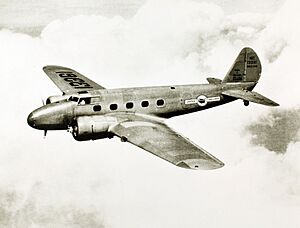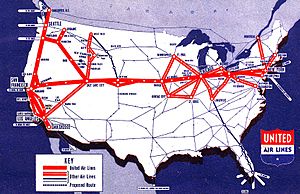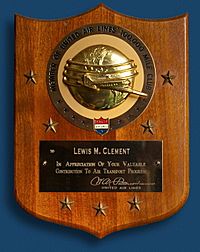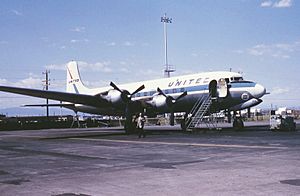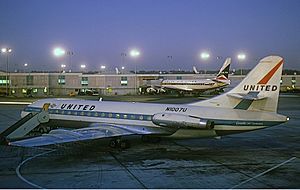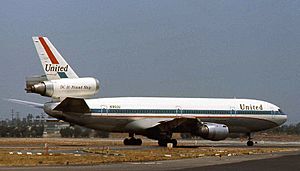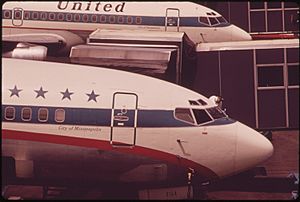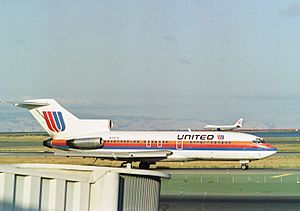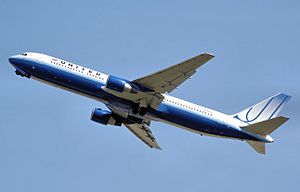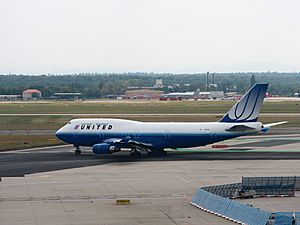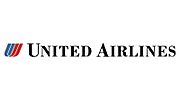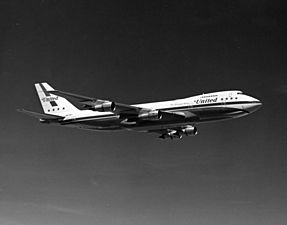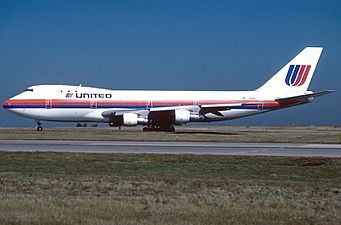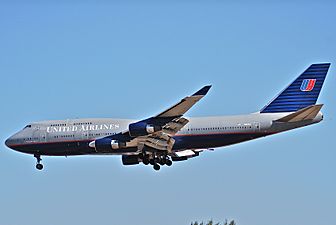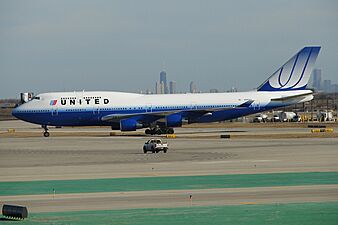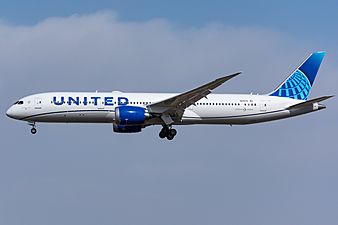History of United Airlines facts for kids
United Airlines was created in 1931 to manage several airlines that William Boeing had bought. These included Boeing Air Transport and Varney Air Lines, which started way back in 1926. United considers 1926 its founding year.
After a big event called the Air Mail scandal in 1934, United became its own company. It grew quickly, introducing the Boeing 247 in 1933, which was the first modern airliner that could fly across the country without stopping. During World War II, United helped the war effort by changing planes for military use and carrying supplies.
After the war, air travel became very popular. In 1961, United joined with Capital Airlines, briefly becoming the second-largest airline in the world. In the 1970s, United supported making airline rules less strict, which helped them grow. They bought many routes from Pan Am in the 1980s and 1990s, including flights to the Pacific, London Heathrow, and Latin America. In 1997, United was one of the first five airlines to start Star Alliance, which was the first big group of airlines working together globally.
United faced a very sad time during the September 11 attacks in 2001, when two of its planes were hijacked and crashed. The airline was already having money problems, and these attacks made things worse. United filed for bankruptcy in 2002 but came out of it in 2006 after making big changes. In 2010, United merged with Continental Airlines, creating one of the largest airlines in the world.
Contents
How United Began
United Airlines was started by a aviation leader named William Boeing. He began his airplane business in 1916. His company, Boeing Airplane Company, made the first international mail delivery by air in 1919. Later, he created Boeing Air Transport (BAT) in 1927.
Boeing's company grew by buying other airlines. In 1928, they bought Pacific Air Transport. Then, in 1929, they changed their name to United Aircraft & Transport Corporation (UATC). UATC continued to buy more airlines, including Stout Air Services in 1929, Varney Air Lines in 1930, and National Air Transport in 1930. Finally, on March 28, 1931, UATC formed United Air Lines, Inc. to manage all these airlines.
Varney Air Lines was founded in Boise, Idaho, by Walter Varney. On April 6, 1926, Varney's main pilot, Leon D. "Lee" Cuddeback, flew the first contract air mail flight from Boise to Pasco, Washington. This flight carried 200 pounds of mail.
By 1930, with all its new airlines, United Air Lines could offer flights for passengers and mail from one side of the United States to the other. These flights took about 27 hours one way. United Air Lines also hired Ellen Church, a registered nurse, to help passengers. United says she was the first airline stewardess.
After the Air Mail scandal in 1930, a new law in 1934 said that companies that built airplanes could not also own airlines. Because of this, UATC was split into three separate companies. The airline part became United Air Lines. A new president, William A. Patterson, was hired in 1934 to lead the airline. He stayed president until 1963.
Growing Across the Country
United's first flight paths were set up by connecting airmail routes. They went from New York City, through Chicago and Salt Lake City, to San Francisco. They also had routes along the West Coast. These early connections became the main centers, or hubs, for United in Chicago and San Francisco. Later, Denver and Washington, D.C., also became important hubs. These cities are still major hubs for United today.
In 1933, United started using the Boeing 247 airplane. This was a big step because, for the first time, people could fly across the United States without stopping overnight or changing planes. A flight from Newark to San Francisco, with eight stops, cost about $160 back then.
On October 10, 1933, a United Boeing 247 plane crashed near Chesterton, Indiana, killing seven people. An investigation found that a bomb had been placed in the baggage area. This was believed to be the first time a commercial airplane was sabotaged. No one was ever caught for this crime.
During World War II, United helped the war effort. They trained ground crews to change airplanes into bombers and used their planes to carry mail, supplies, and passengers. By 1945, United's fifty planes were flying over 100,000 miles every day. After the war, United benefited from new technologies, like pressurized cabins that allowed planes to fly higher, and more people wanted to travel by air.
In 1954, United was the first airline to use flight simulators that had visual, sound, and motion effects to train pilots. These were the first modern simulators for training commercial pilots.
On November 1, 1955, United Airlines Flight 629 was bombed while flying from Stapleton Airport in Denver to Portland. All 39 passengers and five crew members died. The bomb was planted by Jack Graham, who put it in his mother's luggage to get money from her life insurance. Graham was arrested and later executed.
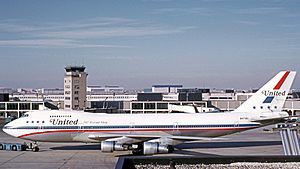
In the late 1950s, three United planes were involved in mid-air collisions, meaning they crashed into other planes in the sky. These accidents, like the one over the Grand Canyon in 1956, helped lead to the modern Air Traffic Control system we have today. Also, in 1958, United received its first Douglas DC-8, which was its first jet airplane.
On June 1, 1961, United merged with Capital Airlines. This made United the second-largest airline in the world at that time. Through this merger, United started flying the British-made Vickers Viscount and the French-made Sud Aviation Caravelle jetliners. In 1968, the company changed its structure, creating UAL Corporation with United Airlines as its main part.
In August 1970, United received its first Boeing 747s, which they used for longer flights within the United States. A year later, United and American Airlines were the first to use the McDonnell Douglas DC-10, which became a very important plane for many airlines.
United Airlines is the only airline that has flown a U.S. president on a regular commercial flight. On December 26, 1973, President Richard Nixon flew on a United DC-10 from Washington Dulles to Los Angeles. This was done to save fuel instead of using the special Boeing 707 plane usually used for Air Force One.
The Deregulation Era
In the 1960s, United wanted to fly to more places overseas, but they weren't allowed to until 1983, when they started flights to Tokyo. United believed that the old rules were holding them back, so they pushed for changes. The 1978 Airline Deregulation Act made it easier for airlines to decide their own routes and prices.
The 1970s were a tough time for airlines, including United, because of money problems and changes in leadership.
In May 1981, United started its Mileage Plus program, which was one of the first modern frequent flyer programs. This allowed passengers to earn points for flying and get rewards.
In 1982, United was the first airline to use the Boeing 767-200. Their order for these planes, along with other jets, was the largest commercial airplane order at that time.
By 1984, United was the first airline to fly to all 50 states that had commercial airports.
In 1985, United agreed to buy the Pacific routes from Pan Am, which was having financial difficulties. By late 1986, United was flying to many destinations across the Pacific Ocean.
The 1985 Pilot Strike
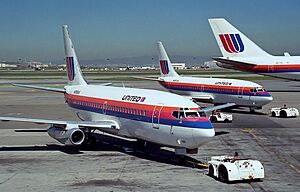
On May 17, 1985, United's pilots went on strike for 29 days. They were unhappy about proposed changes to their pay rates. The strike caused many disruptions, but eventually, the issues were resolved.
In 1987, United's parent company briefly changed its name to Allegis, but it soon changed back to UAL Corp. after selling off its non-airline businesses.
A Record-Setting Flight
In 1988, United flew a Boeing 747SP-21 around the world with two stops to raise money for a charity. This flight set a short-lived record for the fastest flight around the globe.
Employee Ownership and New Look
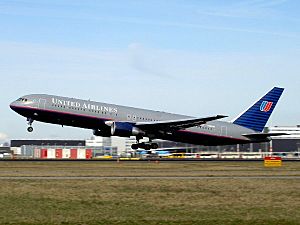
The struggles of Pan American World Airways gave United more chances to grow. In 1991, United bought Pan Am's routes to London Heathrow Airport. In 1992, United also bought Pan Am's routes in Latin America and the Caribbean.
In 1994, United's employees, including pilots and mechanics, agreed to own 55% of the company's stock. In return, they took a pay cut. This made United the largest company in the world owned by its employees. United used this to create a lower-cost airline called Shuttle by United to compete with other budget airlines.
United used its employee ownership in its ads, with slogans like "the employee-owners of United invite you to come fly the friendly skies."
During this time, United also changed its planes' colors to a grey and dark blue design.
New Developments Around 2000
In 1989, United ordered the new Boeing 747-400. In 1993, United changed its logo and plane design to the "Battleship Gray" look. In 1995, United was the first airline to use the Boeing 777, and they had a big say in how it was designed. In 1997, United helped start the Star Alliance with other major airlines like Air Canada and Lufthansa. That same year, United opened a new hub in the southwest U.S. at Los Angeles International Airport.
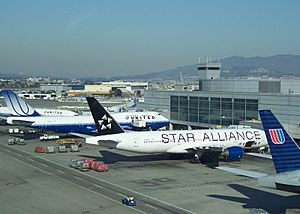
In 1997, a website called untied.com was created to share complaints about United's service. This showed how people were using the internet to talk about their experiences with airlines.
In 1998, Delta Air Lines and United started a partnership that allowed their frequent flyer members to earn and use miles on both airlines.
In May 2000, United announced plans to buy US Airways. However, the government worried this would create too much control for one airline, and United withdrew its offer in 2001. The two airlines later formed a friendly partnership.
Also in May 2000, United had a big disagreement with its pilots' union about pay. Many flights were canceled that summer because pilots refused to work extra hours. Eventually, United offered the pilots a large pay increase.
September 11 Attacks
During the September 11 attacks on September 11, 2001, two of the four hijacked planes belonged to United. United Airlines Flight 175, a Boeing 767, was flown into the South Tower of the World Trade Center. United Airlines Flight 93, a Boeing 757, crashed in rural Pennsylvania after passengers fought back against the hijackers.
Bankruptcy and Reorganization
After the 9/11 attacks, air travel decreased, and fuel prices went up. United, which was already struggling with costs, lost a lot of money. In December 2002, UAL Corporation, United's parent company, filed for bankruptcy protection.
United continued to fly during bankruptcy but had to cut costs a lot. Many workers lost their jobs, and some routes were canceled. For example, they stopped all flights from Miami International Airport after March 1, 2004. They also reduced their main fleet of planes.
Even during bankruptcy, United started new projects. In 2003, they launched Ted, a new low-cost airline. In 2004, they started their luxury "p.s." service for business travelers on flights between New York City, Los Angeles, and San Francisco. That same year, they introduced a new blue and white plane design, called "Rising Blue," to show a fresh start.
The airline faced continued financial pressure from events like the 2003 SARS epidemic, which affected flights to Asia, and rising fuel prices. United had to raise ticket prices on overseas routes.
United used its bankruptcy status to negotiate lower costs with employees and suppliers. One of the most talked-about actions was canceling its pension plan in 2005, which was the largest such event in American corporate history. They also renegotiated contracts with unions for lower pay.
After several extensions, the bankruptcy court approved United's plan to reorganize on January 20, 2006. United officially came out of bankruptcy on February 1, 2006. This was the largest and longest airline bankruptcy case ever.
After Bankruptcy
On December 9, 2004, United made history with a flight to Ho Chi Minh City (formerly Saigon) in Vietnam. This was the first scheduled flight by a U.S. airline to Vietnam since the end of the Vietnam War in 1975.
After leaving bankruptcy, United's management looked for other airlines to merge with. In 2006, there were talks about a merger with Continental Airlines, but it didn't happen then. United also increased its partnerships with other airlines like BMI and Aloha Airlines.
In May 2008, a survey showed that United Airlines was near the bottom for customer satisfaction among U.S. airlines. On June 4, 2008, United announced it would close its Ted airline and change those planes back to regular United planes. They also planned to retire some older planes to cut down on domestic flights. On June 12, 2008, United started charging $15 for the first checked bag, becoming the second U.S. airline to do so.
On September 8, 2008, United's stock price dropped sharply because of false rumors about another bankruptcy. The rumors came from an old news story that appeared as new. The price quickly recovered.
In July 2009, a popular music video called "United Breaks Guitars" was released. It was about a passenger's damaged guitar and his struggle with the airline. United said they wanted to use the video to help train their staff on customer service.
2008 Recession and New Planes
In April 2009, United stopped allowing customers to call general customer service, directing them to reservation agents instead.
In June 2009, United asked Boeing and Airbus to offer proposals for up to 150 new jets. United wanted to take advantage of lower sales at the plane makers to get good prices for new planes. This large order would help update United's older fleet.
Merger with Continental (2010)
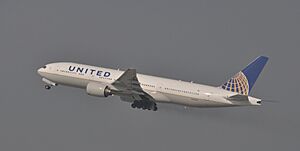
On April 16, 2010, United and Continental Airlines started talking about merging again. On May 2, 2010, the companies agreed to combine. The new airline would be called United Airlines but would use Continental's globe logo and plane design. The main office would be in Chicago.
The merger was approved by the European Union and the U.S. Justice Department. On September 17, 2010, United shareholders approved the deal. The two airlines planned to combine their operations in 2011. On October 1, 2010, UAL Corporation officially bought Continental Airlines and changed its name to United Continental Holdings, Inc.. The two airlines operated separately until they fully combined in mid-2012.
2017 Passenger Incident
On April 9, 2017, a passenger named Dr. David Dao was hurt when he was forcibly removed from United Express Flight 3411. The airline had offered money for volunteers to give up their seats, but when no one volunteered, four passengers were chosen to leave. Dr. Dao refused, and law enforcement officers were called. Videos of the incident were shared widely, causing a lot of negative attention for United Airlines.
Growth and COVID-19
In January 2018, United announced plans to grow its passenger capacity by 4% to 6% each year through 2020.
When the COVID-19 pandemic hit in 2020, it greatly affected airlines. In July 2020, United announced it might have to lay off 36,000 employees. By September 2, 2020, they planned to cut 16,370 jobs. In November 2020, United started preparing to transport Pfizer's COVID-19 vaccine by allowing more dry ice on flights to keep it cold.
Unlike other U.S. airlines, United did not retire any planes during the pandemic. In June 2021, United placed its largest order ever for 270 new narrowbody planes from Boeing and Airbus. They also plan to update the inside of their existing planes with new features by 2025. In December 2022, United ordered 100 more Boeing 787s to replace older planes.
As of mid-August 2021, United was the only major U.S. airline to require its workers to get COVID-19 vaccines by October 25, 2021.
In March 2024, the Federal Aviation Administration (FAA) announced it would increase its safety checks on United Airlines after several safety incidents. However, in October 2024, the FAA ended its increased oversight after finishing its review.
In January 2025, United Airlines announced new flights to Ulaanbaatar from Tokyo Narita, starting May 1, 2025.
Airlines That Became United
United Airlines today is a mix of many different airlines that have joined together over the years. The most recent big merger was with Continental Airlines in 2010.
United Airlines was first formed in 1931 to manage these airlines:
- Boeing Air Transport (started 1927)
- Pacific Air Transport (started 1926, bought 1928)
- Varney Air Lines (started 1926, bought 1930)
- National Air Transport (started 1925, bought 1930)
- Stout Air Services (started 1925, bought 1929, joined National in 1930)
All four of these airlines flew under their own names until 1934, when they combined to form one airline called United. Other airlines that became part of the current United Airlines include:
- Capital Airlines (started 1936, joined United in 1961)
- Pan American World Airways (started 1927, its Pacific flights joined United in 1985, its London Heathrow flights joined United in 1990, and its Latin America flights joined United in 1991)
- Continental Airlines (started 1934, joined United in 2010)
- Pioneer Air Lines (started 1939, joined Continental in 1955)
- Air Micronesia (started 1968 as part of Continental, later called Continental Micronesia, joined Continental in 2010)
- Texas International Airlines (started 1944, bought Continental in 1982 and took the Continental name)
- New York Air (started 1980, joined Continental in 1987)
- People Express Airlines (started 1981, joined Continental in 1987)
- Frontier Airlines (started 1950, joined People Express in 1986)
United's Brand History
Past Logos
In 1936, United used a red, white, and blue shield logo, but it wasn't always used and was eventually stopped in the early 1970s. Before 1974, United often used the slogan "Come Fly the Friendly Skies of United."
In 1973, a designer named Saul Bass created a new logo and look for the airline. This was the "tulip" logo, which looked like overlapping "U"s. It was used starting in 1974, with only small changes, until the merger with Continental in 2010. The planes were mostly white with red, orange, and blue stripes. This design was used for 19 years. During this time, United also started using the song "Rhapsody in Blue" by Gershwin in its commercials.
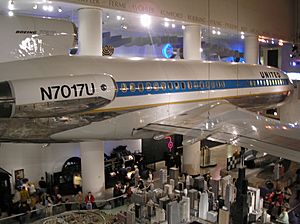
In 1993, United completely changed its brand and plane design. The planes became mostly grey and dark blue with blue stripes on the tail. The "tulip" logo stayed, but it was a bit smaller. This "Battleship" design was meant to make the airline look more serious and global as it expanded internationally.
In 1997, United updated its brand again, but they decided to keep the "tulip" logo because it was well-known. On February 18, 2004, they introduced the "Rising Blue" or "Blue Tulip" design. This new look had a white upper part and a lighter blue belly and tail, meant to show a fresh start after bankruptcy.
-
Boeing 747-100 at Charles de Gaulle wearing Saul Bass-designed "Tulip" livery (1974–1993)
-
Boeing 747-400 at Los Angeles International Airport wearing "Battleship" livery (1993–2004)
-
Boeing 747-400 at O'Hare International Airport in "Rising Blue" or "Blue Tulip" livery (2004–2010)
-
Post-merger Boeing 747-400 at Beijing Capital International Airport in ex-Continental "Globe" livery (2010–2019)
-
Boeing 787-9 at Beijing Capital International Airport wearing the newest livery (2019–present)
On May 3, 2010, when United and Continental Airlines merged, the new airline kept the United name but used Continental's "globe" logo and plane design. This logo was created in 1991.
Many people, including marketing experts, thought keeping the "tulip" logo would have been better because it was more recognizable. However, the CEOs of both companies decided on the "globe" logo themselves.
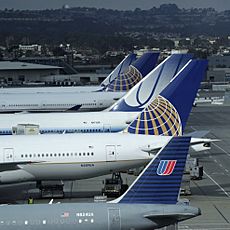
In August 2010, the "United" lettering was updated to match Continental's style, using all capital letters. The merger was approved in September 2010, and the companies officially combined on October 1, 2010.
United revealed an updated plane design on April 24, 2019. It still has a white upper part and gray belly. The "United" name is larger, and there's a dark blue wavy line. The engines, wingtips, and tail are painted in a specific shade of blue, and the globe on the tail is slightly bigger and lighter blue.
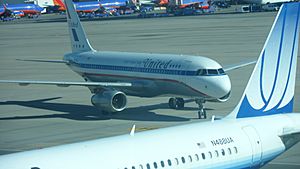
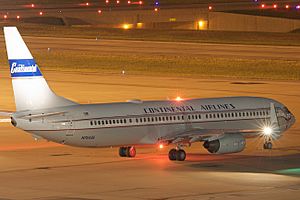
Two United planes in regular service have special old-fashioned paint schemes. One is a Boeing 737-900ER from the Continental merger, painted in Continental's 1950s "Blue Skyways" design since June 2016. The other is a United Airbus A320 with United's 1970s "Stars and Bars" design.
Eleven other planes are painted in the Star Alliance livery, showing their membership in the airline group.
Two planes have a special green and blue design to show United's use of sustainable aviation fuel. This design first appeared in November 2024 on a Boeing 787-9.
Slogans
United's early slogan was "The Main Line Airway." In 1965, it changed to "Fly the Friendly Skies," which was used until 1996 and then brought back on September 20, 2013. Other United slogans have included:
- "The Extra Care Airline" (1963–1964)
- "When you're friendly you do things for people" (1971)
- "Your Land is Our Land" (1972)
- "You're the boss" (1976–1977)
- "United we fly" (1977–1978)
- "United all the way" (1979–1980)
- "Official Airline of the 1984 Olympic Games" (1984 Summer Olympics)
- "Come fly our Friendly Skies" (early 1990s)
- "Airline of the U.S. Olympic Team" (1988 Summer Olympics)
- "We Are United" (after 9/11, used until 2004)
- "It's time to fly" (2004–2010)
- "Let's fly together" (2010–2013)
- "Proud to fly Team USA for over 30 years." (2012–2021)
- "Connecting people. Uniting the world." (2017–present)
- "Good Leads The Way" (2022–present)
Past Hubs
- Cleveland Hopkins International Airport – United used Cleveland as a hub until 1985, then moved its operations to Washington Dulles. After the 2010 merger, United kept Cleveland as a hub for four years but closed it in 2014 because it wasn't making enough money.
- Miami International Airport – Miami became a hub for United in 1991 after they bought Pan Am's international routes from there. In May 2004, Miami was no longer a hub, and its flights were moved to Chicago.
- Tokyo Narita International Airport – This was United's hub for Asia. In its 2017 report, United no longer listed Tokyo-Narita as a main hub.
- Stapleton International Airport – Both United and Continental had hubs at Denver's old airport, Stapleton, from 1972 until it closed in 1995. When the new Denver International Airport opened, United moved its operations there, but Continental closed its Denver hub.
Planes United Used to Fly
| Aircraft | Introduced | Retired | Replacement | Notes |
|---|---|---|---|---|
| Boeing 40A | 1927 | 1937 | First customer to use it. Flew as Boeing Air Transport and Varney Air Lines. | |
| Boeing 80A | 1928 | 1934 | Unknown | First customer to use it. Flew as Boeing Air Transport. |
| Boeing 247 | 1933 | 1942 | Unknown | First customer to use it. All 59 were built for United. |
| Boeing 377 Stratocruiser | Unknown | 1954 | Unknown | |
| Boeing 720 | 1960 | 1976 | Boeing 727 | First customer to use it. |
| Boeing 727-100 | 1963 | 1993 | Boeing 737-500 | |
| Boeing 727-200 | 1968 | 2001 | Airbus A320 family | |
| Boeing 737-200 | 1968 | 2001 | Airbus A320 family | |
| Boeing 737-300 | 1986 | 2009 | Airbus A320 family | |
| Boeing 737-500 | 1990 | 2009 | Airbus A320 family Boeing 737 Next Generation |
United's first 737-500s were retired by 2009. More came from the Continental merger in 2010 and were retired by May 2013. |
| 2010 | 2013 | |||
| Boeing 747-100 | 1970 | 1999 | Boeing 747-400 Boeing 777-200/-200ER |
|
| Boeing 747-200 | 1987 | 2000 | Boeing 747-400 Boeing 777-200/-200ER |
Bought from Pan American World Airways. |
| Boeing 747SP | 1985 | 1995 | Boeing 747-400 Boeing 777-200 Boeing 767-300ER |
10 planes taken from Pan American World Airways. |
| Boeing 747-400 | 1989 | 2017 | Boeing 777-300ER Boeing 787-9/-10 |
The last United 747, called the "Friendship," flew a special tour before its final flight from San Francisco to Honolulu. |
| Boeing 767-200 | 1982 | 2005 | Boeing 757-200 | First customer to use it. |
| Boeing 767-200ER | 2011 | 2013 | Boeing 757-200 Boeing 767-300ER |
Came from Continental Airlines. |
| Convair 340 | Unknown | 1968 | Unknown | |
| Douglas DC-3 | 1936 | Unknown | Convair 340 | |
| Douglas DC-6 | 1947 | 1970 | Unknown | Included DC-6 and DC-6B models. |
| Douglas DC-7 | Unknown | 1964 | Unknown | |
| Douglas DC-8 | 1959 | 1992 | Boeing 757-200 | Was the biggest DC-8 operator. Included stretched "Super 60" and "Super 70" series. |
| Ford Trimotor | Unknown | Unknown | Boeing 247 | Used in 1931 for cross-country flights. |
| Lockheed L-1011 TriStar | 1986 | 1989 | Taken from Pan American World Airways. | |
| McDonnell Douglas DC-10 | 1971 | 2001 | Boeing 747-400 | First customer to use it. Included DC-10-10 and DC-10-30 models. |
| Sud Aviation Caravelle | 1961 | 1970 | Boeing 727 Boeing 737-200 |
Only U.S. airline to use the Caravelle for regular passenger flights. |
| Laird Swallow J-5 | Unknown | Unknown | Unknown | Single-seat biplane used by Varney Air Lines for mail. |
| Vickers Viscount | 1961 | 1969 | Boeing 727 Boeing 737 Original |
Came from Capital Airlines. Only turboprop plane United ever flew. |


